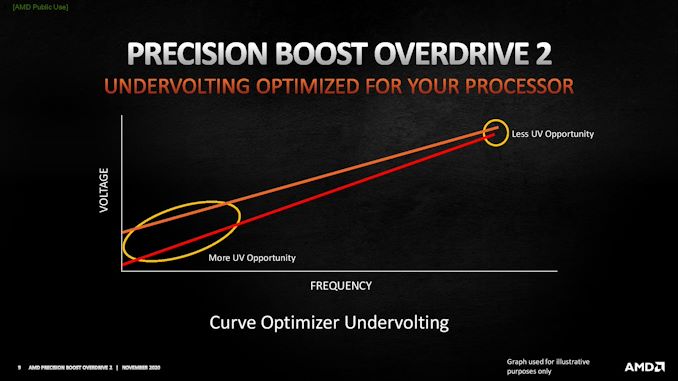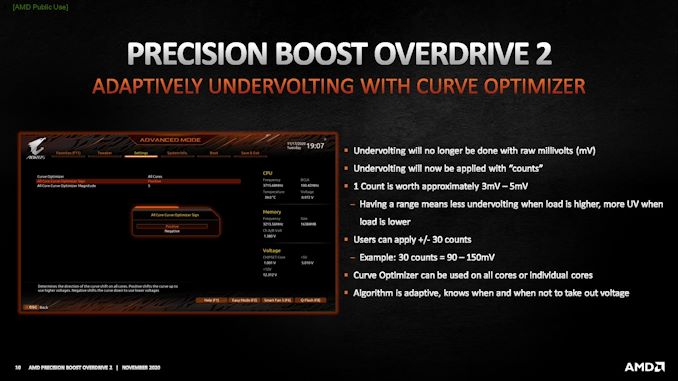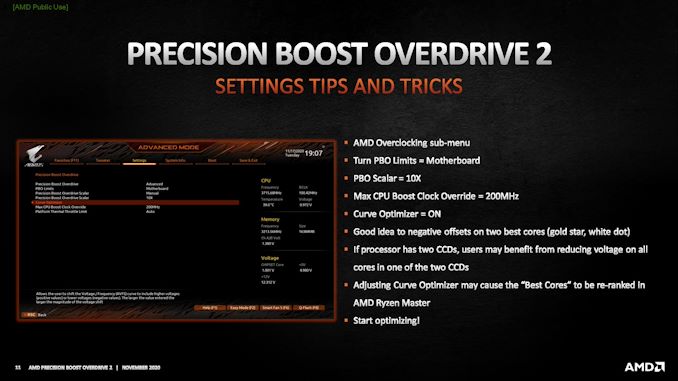AMD Precision Boost Overdrive 2: Adaptive Undervolting For Ryzen 5000 Coming Soon
by Dr. Ian Cutress on November 23, 2020 11:00 AM EST
One of the ways that enthusiasts tinker with their processors is through overclocking: the attempt to get more performance by changing frequencies and voltages, up to the limits of the system. Another way is through undervolting – removing voltage from the processor to help lower temperatures and offer higher thermal headroom (or lower power consumption). It all depends on the silicon, and if it can support it: AMD (and Intel) have to set hard limits for production to enable sufficient yield and costs, but users on certain products can always poke the hardware to try and get something more. With this in mind, AMD is improving its range of overclocking tools to allow for adaptive undervolting of Ryzen 5000 processors.
For any given microprocessor circuit, it requires a minimum voltage to run at a given frequency, before not having enough to complete the process. Most modern processors have a good amount of built-in headroom such that external factors cannot come into play, such as voltage droop based on instantaneous power draw, or as the processor ages, no extra voltage is required. Obviously, a lower voltage means lower power consumption, or more opportunity for higher boost, and so vendors use a variety of techniques to get their processor cores to run as close to the absolute minimum as possible. Despite this, there is always more room to go – vendors have to define a cut-off point between a realistic voltage tracking technique and something that can be scaled for a million processors. Individual users however can skirt those lines for their specific hardware a lot closer than a generic algorithm can.
AMD’s new Curve Optimization tool, to come with AGESA 1180 on 400-series and 500-series motherboard BIOS updates, is designed for this single-user voltage tracking scenario. The goal of the Curve Optimization tool is to opportunistically reduce voltage where possible during low load and high load scenarios, but rather than simply apply a fixed voltage offset across the whole range, it will use other internal sensors (such as workload, temperature, socket limits) to adapt the voltage as required. With AMD’s tool, it should do this on the order of one millisecond, i.e. 1000 times a second.
The Curve Optimization tool will be part of AMD’s Precision Boost Overdrive toolkit, meaning that using it will invalidate the warranty on the hardware, however AMD knows that a number of its user base loves to overclock or undervolt to get the best out of the hardware. The company states that this adaptive methodology will allow for performance gains in both single-thread and multi-thread workloads, as opposed to a standard voltage offset, which they say only really helps with multi-thread examples.
The settings will allow users to test how much adaptive undervolting will be allowed. AMD has tuned the feature such that a user can select how many ‘counts’ or ‘stages’ they want to undervolt by, with each count equating to 3-5 millivolts, up to a maximum of 30 stages. This means that a 10-stage selection will enable a 30-50 millivolt undervolt, depending on the workload and depending on where the control circuitry deems it appropriate.
Performance numbers from AMD would suggest that this technique, compared to a simple fixed undervolt and core frequency increase, can lead to a +2% single thread performance improvement, or up to a +10% multi-thread performance improvement for the Ryzen 9 5900X. AMD stated to us that this technique works best with multiple CCDs, and fewer cores per CCD, so the Ryzen 9 5900X is going to be the best goal for the technology. AMD has also stated that this is going to be applied to all new processors going forward, however it will not be back-ported to Ryzen 3000 as it requires some engineering optimizations in Ryzen 5000 that are non-transferrable.
Users will be able to enable Curve Optimizer through the BIOS initially, with plans to introduce it to AMD’s Ryzen Master software toolkit for Windows sometimes in the new year. Users should note that the best CPU designations inside Ryzen Master may change with these settings, given that the software will see different voltage/frequency curves than at stock. A few motherboards have the feature already present in AGESA 1100 today, however the official rollout will occur with AGESA 1180 firmware updates, initially set to hit the support pages for each motherboard in early December.
Related Reading
- AMD Zen 3 Ryzen Deep Dive Review: 5950X, 5900X, 5800X and 5600X Tested
- AMD to Support Zen 3 and Ryzen 4000 CPUs on B450 and X470 Motherboards
- AMD Clarifies "Best Cores" vs "Preferred Cores" Discrepancies For Ryzen CPUs
- AMD Zen 3: An AnandTech Interview with CTO Mark Papermaster




















59 Comments
View All Comments
Sharma_Ji - Tuesday, November 24, 2020 - link
Yeah LTT demonstrated.Redstorm - Monday, November 23, 2020 - link
The Curve Optimization tool will be part of AMD’s Precision Boost Overdrive toolkit, meaning that using it will invalidate the warranty on the hardwareDon't you mean it will NOT invalidate the warranty?
Gigaplex - Monday, November 23, 2020 - link
PBO does invalidate the warranty.oRAirwolf - Monday, November 23, 2020 - link
How can they tell? Does it burn out a resistor on the cpu or something?sld - Tuesday, November 24, 2020 - link
PBO Auto aka Core Boost keeps the warranty.PBO Enabled, which raises all the wattage, current, temp limits past stock, invalidates the warranty.
Oxford Guy - Wednesday, November 25, 2020 - link
It seems you are unfamiliar with the fact that CPUs have 'black box' secondary CPUs lurking in them.Spyware has a multitude of uses, including warranty invalidation.
Invalidating a warranty for undervolting is completely absurd and should be called out by Anandtech.
WaltC - Saturday, November 28, 2020 - link
Absolutely no reason for such paranoia...;) Even if AMD could prove that a user had invalidated his warranty by running overclocked--even *if*--denying the RMA based on that would be foolish for a number of practical reasons. For one thing, the cost of defending itself in a warranty denial case would amount to 5x-10x what replacement silicon would cost AMD *just to file the paper work* to defend such a case...;) They're going to send the replacement CPU, no question. The only ime I might imagine them denying warranty replacement is if there's obvious physical damage done to the CPU like shorting or broken pins, or some other damage not related to a manufacturing defect. They aren't "spying on you or me" and probably no one at AMD even knows we're alive, let alone addresses and phone numbers. Not even our email, unless we give it to them. We just aren't that interesting, believe it or not...;)jerrylzy - Thursday, December 31, 2020 - link
Still makes no sense to void warranty for undervolting. If they void warranty for overvolting, I can understand the reasons behind it.MrSpadge - Monday, November 23, 2020 - link
This is a smart way to undervolt. I always wondered why the setting for a constant offset was there for CPUs with boost anyway, as it just doesn't fit over a larger dynamic range.However, I do not yet understand how this works in practice. Will the software automatically find the lowest voltage curve for all cores individually? Based on which criterion does it decide / test the minimum voltage? How long does this test take? Or do I have to test manually?
@AMD: why do I have to activate PBO to use this and void my warrenty? Undervolting can in no way damage the CPU, right? Compromise: by default undervolting with PBO2 can be used. The warrenty is voided only if one explicitly agrees to unlock the overclocking settings.
ChaosFenix - Monday, November 23, 2020 - link
Because AMD needed an even bigger lead in multi threaded workloads.